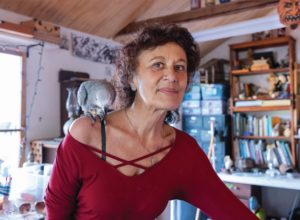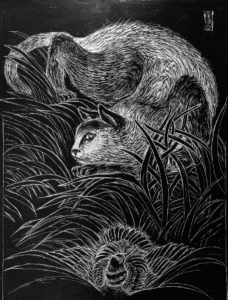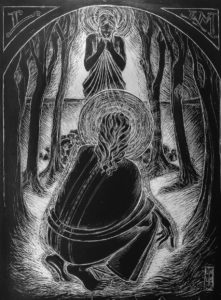In the Gospels of Matthew and Mark, Jesus comes upon a fig tree toward the end of a long journey. Hungry, he curses the tree when he finds only leaves, no fruit. Although Jesus left the tree withered and incapable of bearing figs ever again, it yielded a different kind of fruit for Mary Gordon, Ellen LeBow, and Suzzy Roche — three women collaborating on a project integrating image, narrative, and music.

Gordon, known for her fiction and writings on religious themes, wrote a poem in which Jesus and the tree speak of reason and appetite. The poem is one of a series offering unconventional perspectives on familiar Bible stories, which followed the publication of Reading Jesus, Gordon’s reflections on the Gospels.
The unusual collaboration began to take shape when musician Suzzy Roche of the Roches wrote a song in response to one of the poems. Soon, Gordon, who summered on the Cape for over 20 years, enlisted Wellfleet artist Ellen LeBow to create images. It was the poem about the fig tree that caught LeBow’s attention.
“That was the first one that really made me want to do this project,” says LeBow. “Here’s this elevated being walking around acting like a petulant child.”
“It’s inexplicable,” says Gordon. “You can’t put a good gloss on it. You can feel his hunger. That’s what hunger can make you do.”
Jesus stands at the center of LeBow’s image, his hand stretched toward a withering tree with a crowd of followers behind him. LeBow created the piece in her signature style, scratching into a clayboard surface covered with India ink to achieve a luminous black-and-white image.
Although not religious herself, LeBow is inspired by devotional art, which she interprets as “portals into someone’s spiritual connection to God.”
In the drawing of the fig tree, Jesus and his followers are depicted in a flat, stylized manner reminiscent of Byzantine art. LeBow uses the white surface to create an internal swirling light source that reads as both destructive and illuminating.
“She was able to get the tension of it,” says Gordon, who was drawn to LeBow’s use of narrative and command of the figure in addition to her “appetite for the sacred.”
For LeBow, it was Gordon’s complication of the sacred that drew her in. “She just turns everything on its head,” says the artist. “My irreverence responds to it.”
Gordon gave LeBow and Roche artistic freedom to respond in their own ways. “I didn’t want them to be straight-ahead illustrations,” says LeBow. Although some of her pieces stick close to the narrative and images in the poems, in others she interprets the texts more loosely.
For the poem “In Praise of Self Forgetfulness,” LeBow drew a menacing cat stalking a bird that’s pretending it can’t fly. The bird behavior was something she had seen in the Province Lands. The drawing’s style channels Japanese brush paintings of cats.

In response to the poem “We Raise Up Lamentation,” LeBow used a scene she saw in Haiti, where she has developed a strong connection over many years. It’s an image of rural women sitting on their knees, their hands stretched out in petition to God.
“The gesture stuck with me forever,” LeBow says. In her drawing, ribbons rise from the figures “inspired by the many paintings and carvings from past centuries depicting earthly language being raised to the divine on actual ribbons.”
“I started crying,” says Gordon of her initial reaction to LeBow’s interpretations. “This is kind of mine and kind of not mine.”
Some creative decisions required negotiation. Early in the process, LeBow created a series of works with Jesus having hair reminiscent of the Buddha. “I can’t stand the Anglicized image of Jesus,” LeBow says. Raised Jewish and intrigued by overlapping religious beliefs, she considers “Christ a concept that goes through all enlightened beings.”
Gordon, who is Catholic, found the Buddha imagery “made it too general.”
“The poems are embedded in a narrative, a specific person, not a general deity,” says Gordon. The two resolved their differences with a trip to the Metropolitan Museum of Art in New York, where they looked at early Christian images of Jesus.

“They’re very stylized but didn’t resemble postcard Jesus,” says LeBow.
She found a solution. “I was able to modify my characterization of him with long hair but more connected to older, powerful imagery.”
The collaboration, with starts and stops over the course of a decade, allowed the women to “go back to older traditions and try to do something new with them,” says Gordon.
One of their innovations is centering the female perspective, evident in poems including “The Prostitute,” inspired by the story of Jesus extending mercy to a woman caught in adultery. Gordon’s poem is in the voice of the woman; in LeBow’s drawing, Jesus is crouched on the ground with the woman standing, commanding the viewer’s attention.
The three women met often in New York City, where Roche and Gordon live. The project offered an opportunity for creative fellowship.
“Sitting in a bar with them talking about the project was like taking vitamins,” says LeBow. “We’d get high on each other’s thoughts.”
Three Women and the Gospels
The event: “Unprayed Prayers”: Ellen LeBow’s art and Mary Gordon’s words
The time: The LeBow exhibit runs from July 8 to 20; Mary Gordon reads on Tuesday, July 12 at 5 p.m.
The place: Rice Polak Gallery, 430 Commerical St., Provincetown
The cost: Free
